Fly-drive Chile
From the driest place on earth to glaciers
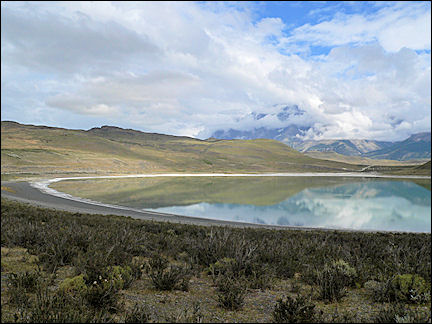
|
Hopping back and forth over the Argentinian border, the following places are visited: the port city of Arica in the north, which has buildings designed by Eiffel; the Atacama Desert; the capital Santiago de Chile; Santa Cruz, the disappointing center of wine trade; Pucón on Lake Villarica; Torres del Paine with wild mountains, glaciers and lakes; Punta Arenas on the Strait of Magellan; Viña del Mar and Valparaïso.
Travelogue:
Ankie Kaskens
Photos:
Peter Kaskens
Taxi drivers and their old cars guide us to the border between Peru and the far north of Chile. All our luggage is scanned for fruit and other perishable goods. We are dropped off in front of our hotel in the port city of Arica.
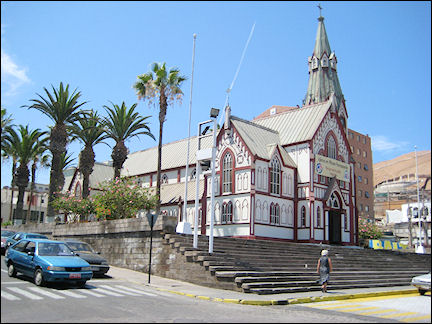
|
Eiffel designed a lot of buildings in Chile. Arica has three of his buildings: a basilica, the train station and the former customs building, all of them cast-iron constructions. They are all earthquake-proof, even though the last earthquake here took place a long time ago. Still there are instructions in our hotel room about where to stand in case of an earthquake.
We take a stroll along the local fishmarket by the sea. A merchant shows us his goods and tells us the names of each kind of fish. Arica's town center isn't all that big, so we see all Eiffel buildings during our walk. We pass an old train car that houses a restaurant. This place is much more laid back than Peru: cars even stop for us when we're not on pedestrian crossings.
In colonial times silver from Potosi in Bolivia was shipped from Arica. Between 1879 and 1884 Chile fought the Saltpeter War with Peru and Bolivia and won the rights to win salt and copper in this province; Bolivia lost its sea access.
We drive through the Atacama Desert to San Pedro de Atacama at night. We don't see anything of the landscape, but we see the starry sky. It's so clear that the world's most important observatories were all built here.
San Pedro de Atacama is a backpackers desert town with unpaved streets on the border with Bolivia. It's at an altitude of 2,500 meters on the Puna de Atacama plateau, overlooking the Licancabur volcano. It has a population of 5,000, but with the backpackers added at least twice as much.
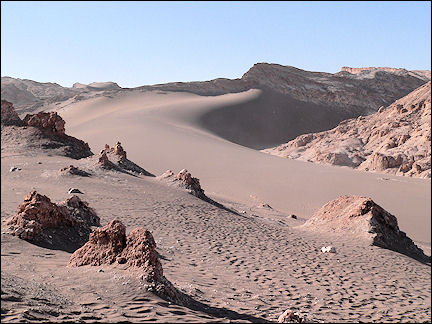
|
This is one of the driest spots on earth; it's interesting to visit because of the geysers of El Tatio, the salt plains of Atacama, the Licancabur volcano, the Moon Valley and the Valley of the Dead. There are tours to all these places.
Late in the afternoon we take a trip to Moon Valley to see the sunset. First we hike through a canyon. It's so dry here that you can hear the loam creak. Every creak is a crack. The sunset is somewhat disappointing. Tomorrow we cross the border into Bolivia.
Santiago de Chile
An old church next to a glass office tower
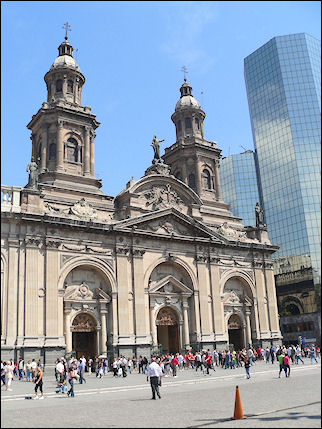
|
After our wanderings in Bolivia we land on the airport of the Chilean capital Santiago, 1,500 km farther south than Atacama. It takes a while before we can pick up our car at the rental company, because the clerk keeps asking us questions about Europe. He would like to go there. Meanwhile he is busy on the computer. Much later, after our return home, it turns out he made a lot of mistakes in our disadvantage.
Because we can't get a map of Santiago in the airport, we have to use the sketch the car rental company provides. It's not very clear and the street where our hotel is, isn't on it. After a lot of guessing and asking in our best Spanish, we finally arrive at our hotel in the business district Las Condes.
It's a Sunday night and extremely quiet in the streets. Some restaurants are open, though, as are a few diminutive supermarkets.
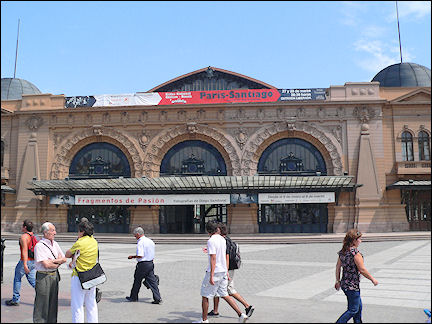
|
The next morning we explore by subway. It turns out that Santiago has an excellent and very affordable subway network.
We travel to the city center and find Plaza de Armas. The old cathedral stands next to a glass office tower. At the end of the shopping street is the old central fishmarket, another design by Eiffel.
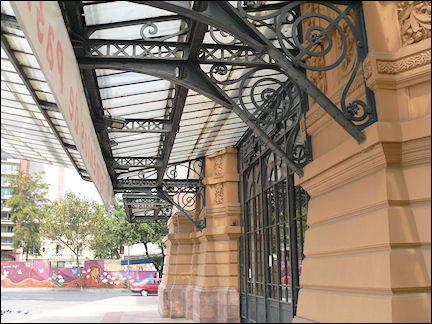
|
On the opposite side of the street is an exhibition hall in the same style. The fishmarket houses several restaurants, where you can have lunch until 5 PM, after which the building is closed. And, of course, you can buy fish and fruit there, too.
Because we have been traveling through the northern countries of Latin America (by public transportation) for the last two months, we didn't want to carry too many maps and guides with us. So we start out to look for Lonely Planet guides and road maps. The tourist information kiosks only have some brochures about Santiago and the selections that bookstores have are very limited.
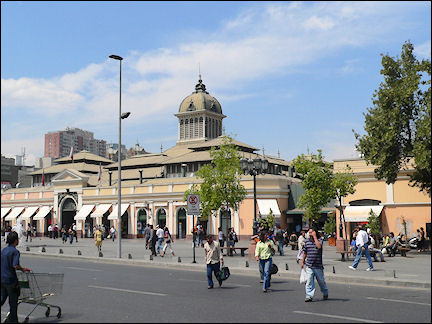
|
We have to walk a lot this afternoon to get everything we need. When we finally find a Lonely Planet Argentina, the cashier is curt. We find out quickly that Chileans have a strong dislike for Argentina and we wonder if it's the same the other way around.
The city center of Santiago isn't very big and is filled with stately (bank) buildings. On one side is a park on a hill and in the neighborhood next to it are streets with nice restaurants.
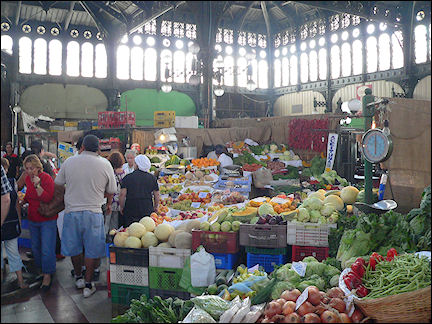
|
We cross the Mapocho river into the student district of Bellavista, which has lots of small shops. In this part of town you'll find jewelry with lapis lazuli, an azure-blue semiprecious stone. But it isn't supposed to be one hundred percent safe here at night.
We find some stores and a restaurant on a courtyard. We decide to have dinner here. We take the subway back to our hotel in Las Condes.
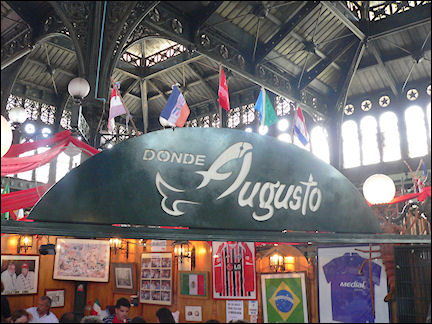
|
The next morning we first pick up our permit for Argentina and take the subway to a large shopping mall, where we browse. Tomorrow the adventure really begins. We will be back in Santiago at the end of the trip.
Santa Cruz
The center of wine trade
We drive south to the wine regions on Ruta 5 Sur. We exit at San Fernando, a hot, messy town, and follow the Colchagua Valley to Santa Cruz. The route takes us along vineyards, but we are a little disappointed. There are big, steel wine tanks everywhere, it's very dusty and there are no signs of cabanas (vacation homes), which we would like to rent for a few days.
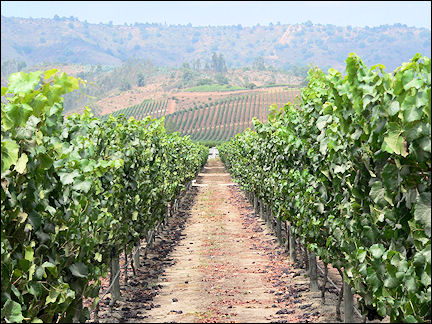
|
Santa Cruz is touted as the center of wine trade in the region; rural tourism is developing. There is supposed to be a helpful tourist office on the Plaza de Armas. After we find a hotel, we go explore.
We're not overly impressed with Santa Cruz, but maybe the tourist office can help us find accomodation in the region. When the office opens at 6 PM, it only has information about local drinks and food, but no tourist information at all.
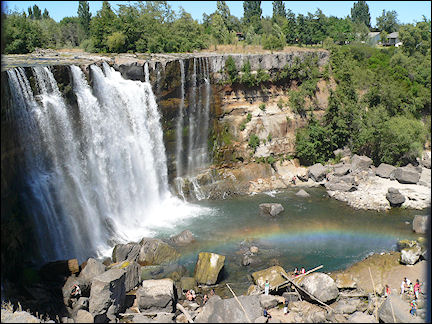
|
The next day we decide to continue on our trip and drive farther south on Ruta 5. Every now and then we have to stop at a toll booth to pay the equivalent of 2.50 euro. The highway is quiet and the landscape is rather level.
25 kilometers north of Los Angelos we take the exit to Salto del Laja. The area around the waterfall is popular for recreation, especially now, during Chile's vacation period. We join the vacationers and book a hotel room for one night. There are several hotels and campings, which have lots of guests.
Pucón
Villarica volcano is obscured by fog
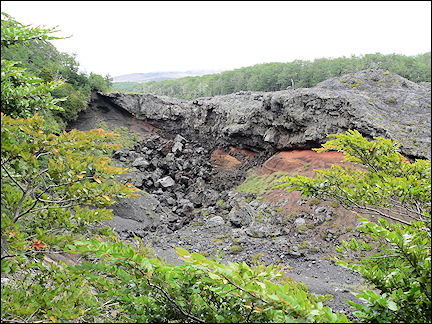
|
We drive farther south to Pucón. To our left we still have views of the Andes and volcanoes. The landscape gets greener and we feel al little as if we're in Germany. There are woods and grainfields.
Not only was this cultivated landscape shaped by Germans who immigrated here in the early 20th century, the population also looks German. After 1945 the German element increased with Germans who fled their country to evade punishment for their involvement in war crimes. Often they had relatives here who were willing to give them shelter and even hide them.
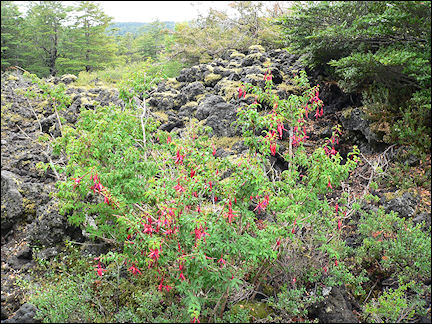
|
We find a hotel in Pucón and book for three nights. The elderly couple that run the place, look as if they are from Germany.
Pucón is a nice town on Lake Villarica. Engough restaurants and many companies that offer all kinds of outdoor activities, both for summer and winter. Which makes the town attractive for the many backpackers who visit here for adventurous tourism.
On Sunday there will be an Ironman triathlon in Pucón. On Saturday afternoon we watch the preparations and meet one of the athletes whose name is Dijkstra. He is Argentinian and doesn't speak Dutch, but knows that his ancestors came from Frysia in The Netherlands.
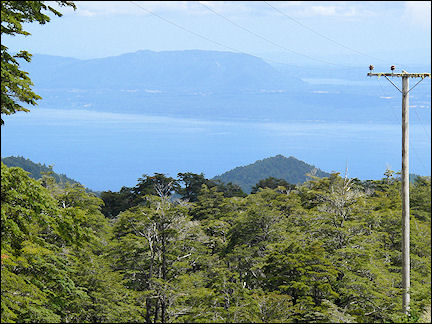
|
Most participants are from Chile, Argentina and Brazil; only in the age category over 60 there are many Americans. It's busy in Pucón on Sunday.
Pucón is near Villarrica National Park with Villarica volcano. The road to the park is paved with road metal and this is our first experience with this type of road. We pay a small entrance fee and drive up the volcano. On the way we find ourselves in thick fog. Together with other disappointed visitors we go back, because the fog doesn't lift.
We take a long walk on the lava fields and through woods at the foot of the volcano. On the way we have great views of the lake.
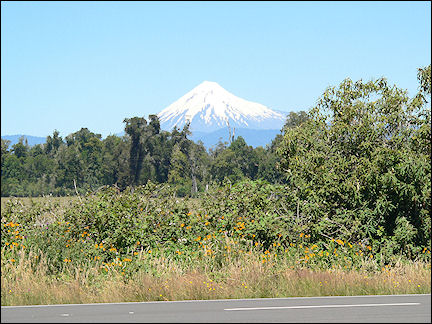
|
We are back on Ruta 5 and drive a little farther south. We exit to the left at Osorno into the Andes mountains in the direction of Argentina. The road takes us along beautiful lakes, among which Lake Pulehue. It's very quiet here.
Eventually we arrive at a Chilean border control post. We have to fill out some forms that have to do with our car, but they are not collected by the customs officers. We drive on and wonder where the Argentinian border is. Half way the border is marked by a memorial and some kilometers farther is the Argentinian border control post.
Torres del Paine
Wild mountains, glaciers and lakes
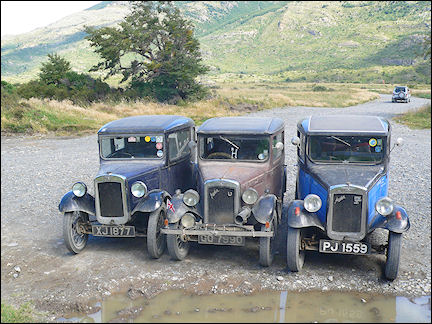
|
After our explorations in Argentina we cross the border back into Chile at Dorotea. We leave Argentina without problems, we get rid of one form in our stack and drive a few kilometers to the Chilean border. We're not so lucky here: we are behind a busload of travelers and that takes time.
It also takes time to import the car, forms are looked at, eventually the last form in our stack is taken in and our car is back in its homeland. Then all our luggage has to be scanned because of the ban on importing fruit.
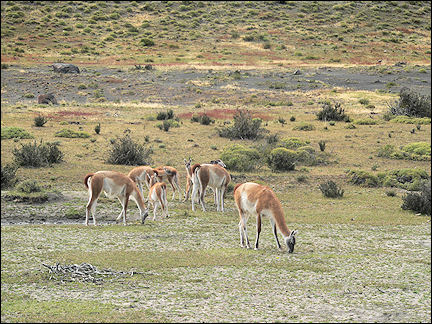
|
We are a lot farther south, in the Chilean province of Última Esperanza (Last Hope). We drive from the border to Puerto Natales, where we find a B and B without any problem. The owners are again German types.
Puerto Natales is a small town on a fjord. We book a tour for the next day, to Torres del Paine, the best-known national park in South America. The park is a paradise for hikers, but we are not that sporty.
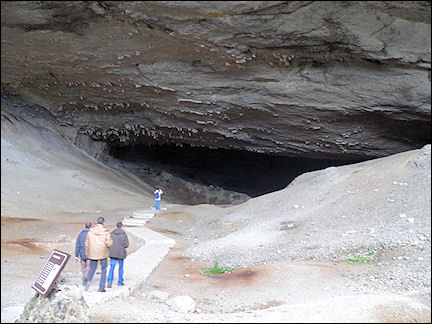
|
The refugios are very expensive in this park and there is a risk that during the exhausting 9-hours walk to Torres, one of the best-known peaks of the Paine massive, you will only see fog. Along the whole west coast of South America there is often fog.
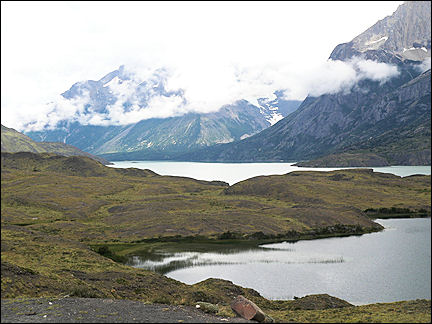
|
Before we arrive at the park, we visit a cave, the Cueva del Milodon, which was discovered in 1896. Bones and hide of a giant leopard, the milodon, were found here. The animal was around three meters tall. It became extinct around 10,000 years ago.
We continue on to the park. On the way we see all kinds of animals: extraordinary water fowl, a fox with cubs, etc. The guanacos aren't bothered by our presence, they keep grazing. Only when we get very near, they take a few steps.
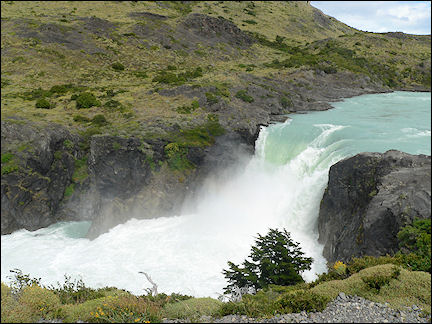
|
At the spot where we should be able to see the Torres in the distance, we find out that they are covered in thick clouds. It's a pity, but we'll see so many wonderful things today that we accept this disappointment.
We drive in the park all day long, along lakes and plateaus and we stop at all important observation points. There's a posh hotel on Lake Pehoe, built by Americans, where all kinds of activities in the park are organized, for a stiff price./p>
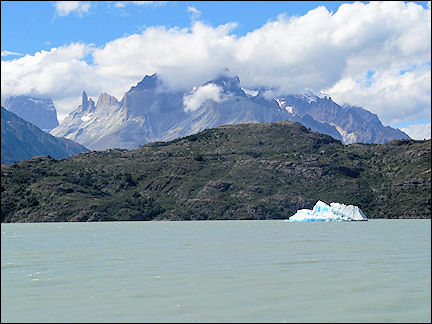
|
We have lunch at one of the refugios. From there we walk by way of a dam to a point where we see the Grey glacier end in the lake of the same name. The mountains here look wild and rugged.
We frequently meet hikers with tents and backpacks. This park is immensely popular with hikers, there are several trails that take more than a day.
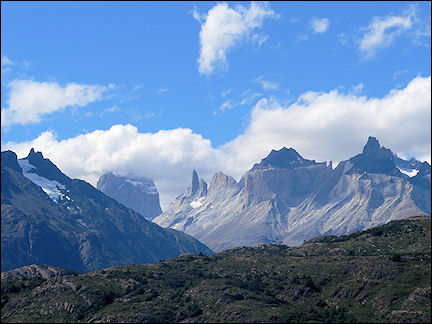
|
Campers are restricted with regard to making fire, especially after part of te park burned down in 2005 when a camper was careless. You are not allowed to stray off the paths and camping is only allowed on camping sites.
You have to watch out for quickly changing weather circumstances as well. Today the weather is okay, even though it's chilly and there's a strong wind.
Punta Arenas
Along the Strait of Magellan
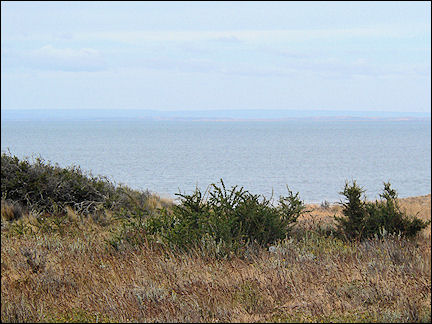
|
The next day we drive to Punta Arenas, a 200 kilometers trip. The route takes us through a hilly, green area with large farms. Along the two-lane road are bus shelters, one in front of every farm's driveway. But we don't see a bus during the whole drive.
We have to renew our permit to enter Argentina in Punta Arenas. These permits are only valid for 30 days and we have rented the car for 49 days. According to our calculations if we renew it now, it'll be valid for the rest of our trip.
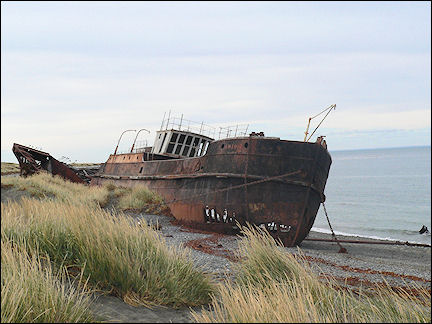
|
Punta Arenas on the Strait of Magellan is not a very interesting town. It has a tax-free shopping mall, but not much more. We skip the nearby penguin colony, because later we will visit more of those.
The next morning we begin our great trek north from this most southern town in Chile. The first leg is still in Chile, along the Strait of Magellan.
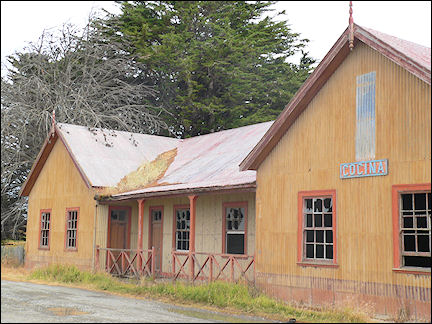
|
In the middle of nowhere we see an old farmhouse, judging from an inscription the owners were Italian. It is deserted. We cross the border and drive north in Argentina.
Viña del Mar
Also here there is often fog along the coast
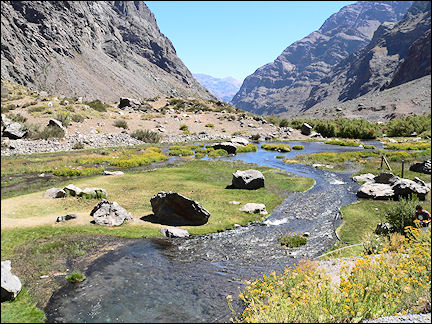
|
We drive west over the mountains from the Mendoza Valley and cross the Chilean border again north of Santiago. In Chile we descend on a spectacular road with hairpin turns into a green valley.
We would love to spend the night here, but we see only one hotel and it is closed on Sundays. The Chileans haven't thought yet of exploiting beautiful places like this. We eventually find a hotel in Los Andes.
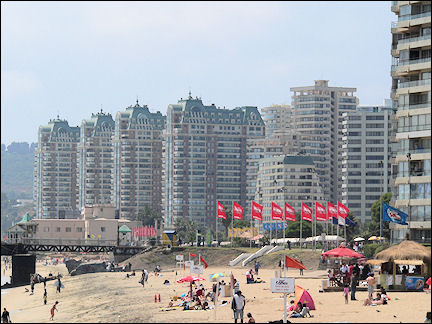
|
The next day we drive farther west through a pretty wine region to Viña del Mar, a beach resort next to the big port city of Valparaïso.
It's hard to find a room in Viña del Mar, because of the annual song festival. In one of the more expensive hotels we get a room, but only if we book for three nights. There are groups of youngsters in front of every hotel, who hope to catch a glimpse of their favorite singer. Our hotel houses the tv-crews.
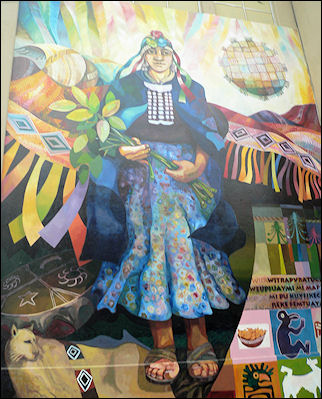
|
It turns out there is often fog here as well, the sun breaks through only around noon every day. In the morning it's chilly and sometimes there's a drizzle. The beaches aren't crowded at all, but it's the end of the summer season anyway.
Bad luck: one of our cameras is stolen, so we miss part of the photos we took. We go to a police station and report the theft in our best Spanish. Fortunately we get help from another visitor who speaks English.
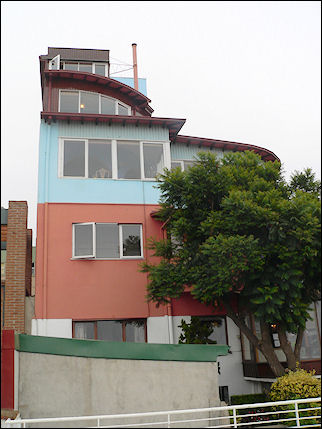
|
We take an excursion to Valparaïso. An extraordinary city, built on hills and the most important port city of Chile. We are taken to the house of the poet Pablo Neruda, who won the Nobel Prize for Literature.
It's an attractive house built on a slope and with a beautiful interior. In Santiago and near Casablanca (a nearby wine region) you can visit two more houses of this poet.
We take a city walk with a guide who speaks English, but his German is even better. He learned it at the Goethe Institute in Santiago.
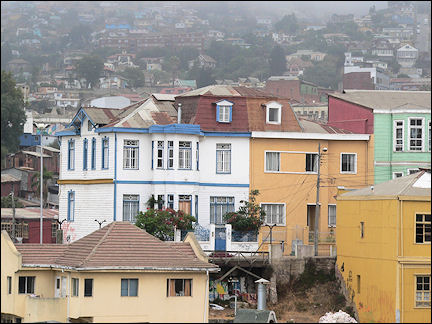
|
Valparaïso is a beautiful city with colorful buildings which are being restored currently. Many buildings house B-and-B's. In the yuppie districts the real estate prices are steep.
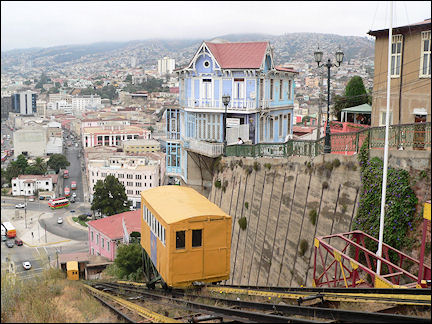
|
Because of the differences in altitude there are elevators and cable cars everywhere, the so-called ascensors. We take on of those up and then walk back down to take a look at the port before the bus takes us back to our hotel.
The last leg is back to Santiago. We exit the highway at Casablanca to take a look at the wine region. It looks attractive. We visit an ultra-modern winery, which has its own laboratory.
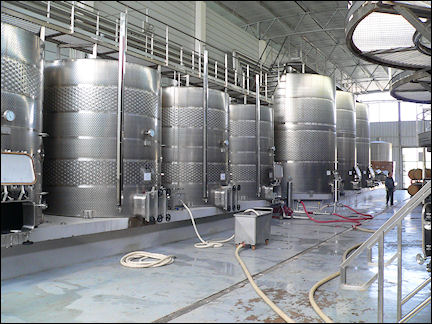
|
Because we still need to drive, we pass up a five-course lunch with different kinds of wine and continue on to Santiago, where we have booked a room in a 5-star hotel. We got a good discount, so it's affordable.
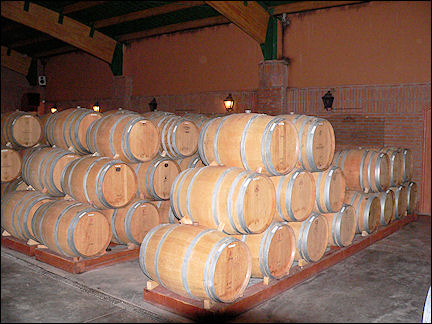
|
With help of the city map we drive straight to the Park Plaza Hotel in a quiet street with beautiful trees. We return our rental car and still have time to re-take the pictures of Santiago we lost. And that's what we do, we spend some hours in the city center.
The first leaves are falling off the trees, fall begins. We go home tomorrow, where it will hopefully soon be spring.